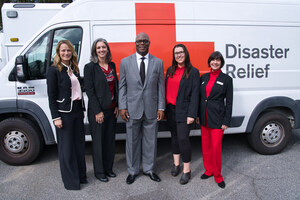New American Red Cross Survey Finds High Expectations on Response Organizations
WASHINGTON, Aug. 24, 2011 /PRNewswire-USNewswire/ -- Americans are relying more and more on social media, mobile technology and online news outlets to learn about ongoing disasters, seek help and share information about their well-being after emergencies, according to two new surveys conducted by the American Red Cross.
(Logo: http://photos.prnewswire.com/prnh/20090108/RedCrossLOGO)
The surveys, one by telephone of the general population and a second online survey, continue to show that the vast majority of Americans believe response organizations should be both monitoring social media during disasters and acting quickly to help.
"Social media is becoming an integral part of disaster response," said Wendy Harman, director of social strategy for the American Red Cross. "During the record-breaking 2011 spring storm season, people across America alerted the Red Cross to their needs via Facebook. We also used Twitter to connect to thousands of people seeking comfort, and safety information to help get them through the darkest hours of storms."
- Followed by television and local radio, the internet is the third most popular way for people to gather emergency information with 18 percent of both the general and the online population specifically using Facebook for that purpose.
- Nearly a fourth (24 percent) of the general population and a third (31 percent) of the online population would use social media to let loved ones know they are safe;
- Four of five (80 percent) of the general and 69 percent of the online populations surveyed believe that national emergency response organizations should regularly monitor social media sites in order to respond promptly.
- For those who would post a request for help through social media, 39 percent of those polled online and 35 of those polled via telephone said they would expect help to arrive in less than one hour.
The surveys, which polled 1,011 telephone respondents and 1,046 online respondents, found that those from the online survey population use a variety of technologies to both learn more about disasters and share information about their well-being, including Facebook, Twitter, text alerts, online news sites and smart phone applications, suggesting that there is no one-size-fits-all approach to using these tools during disasters.
In contrast, people participating in the telephone survey tended to be more reliant on traditional media and non-social websites like those belonging to local news outlets, government agencies or utility companies. The Red Cross survey also found that women and households with children are more likely to use social media channels to inform others of their safety.
The survey findings show that the increasing use of social media and mobile technologies to get disaster information and to seek help should cause response agencies to adjust their procedures to use social media more to engage with people in times of disaster and to include information from social networks in their response efforts.
"Calling 9-1-1 is always the best first action to take when a person needs emergency assistance, but this survey shows there is an opportunity for emergency responders to meaningfully engage their communities on the social web," said Trevor Riggen, senior director of disaster services for the American Red Cross. "Traditional media such as television and radio are still important ways to reach people with emergency information but the social web offers a chance for emergency responders to understand in real time what their communities care about and need – and to become part of the fabric of the community."
On an average day, the Red Cross is mentioned 3,000 times in the social media space. During a disaster, those mentions grow exponentially and range from people asking for help to those looking for a way to help their neighbors to suggestions for monetary donations.
"As the numbers of people using these new technologies in disaster situations continue to increase, response agencies, including the Red Cross have a tremendous opportunity to engage the public where they are spending time," said Harman. "Through social media, we can listen to, inform and empower people prior to emergencies, providing them with useful information about evacuation routes, shelters and safety tips before disasters strike."
In August 2010, the Red Cross hosted an Emergency Social Data Summit at its headquarters in Washington, D.C. More than 150 people – leaders and experts in the government, social media, emergency response and the nonprofit sectors – attended the full-day summit to discuss how organizations might begin to listen to and potentially act on information that flows through the social web during disasters.
In the year since the Summit, the Red Cross has created a process to route life-threatening cries for help to local first responders. The organization has also increased its commitment to listen and engage social communities with a planned digital volunteer role, and continues to work with emergency response colleagues on processes and protocols for taking action on incoming information during disasters.
The Red Cross also offers two free mobile applications—one that provides shelter locations and the "American Red Cross SOS" app that teaches first aid and CPR. The shelter finder app can be accessed through the Apple app store and the SOS app can be accessed through the Android marketplace. The Red Cross has also integrated Facebook and Twitter into the Safe and Well site, so people can register that they are safe and update their social media status and let others know how they are doing.
This is the second year the Red Cross has studied the use of social media and other technologies in emergency situations. The Red Cross decided to broaden the survey audience and produce a more in-depth look at trends. This year's study surveyed more than 1000 members of the general public and more than 1000 online users. The 2010 survey included only data from 1,058 online respondents. This year's survey demonstrates an increasing reliance on online news and information in emergencies as well as increased participation in social networks.
For more information and to view the full survey, visit www.redcross.org.
Survey details: Two similar polls were fielded during the period of June 23-27 by CARAVAN® ORC International using two methodologies: Telephone survey of 1,011 U.S. Adults 18 years and older on June 24-27, 2011. Margin of error is +/- 3.1 percentage points at the 95% confidence level. Online survey of 1,046 survey respondents aged 18 and older on June 23-27 on June 23-26, 2011. Respondents for the online survey were selected from among those who have volunteered to participate in online surveys and polls. The data have been weighted to reflect the demographic composition of the 18+ population. Because the sample is based on those who initially self-selected for participation, no estimates of sampling error can be calculated. Comparison Sample From: When appropriate, comparison values have been included from the previous online survey of 1,058 respondents aged 18 and older conducted on July 22-23, 2010 by CARAVAN® ORC International.
About the American Red Cross:
The American Red Cross shelters, feeds and provides emotional support to victims of disasters; supplies nearly half of the nation's blood; teaches lifesaving skills; provides international humanitarian aid; and supports military members and their families. The Red Cross is a charitable organization — not a government agency — and depends on volunteers and the generosity of the American public to perform its mission. For more information, please visit www.redcross.org or join our blog at http://blog.redcross.org.
SOURCE American Red Cross
WANT YOUR COMPANY'S NEWS FEATURED ON PRNEWSWIRE.COM?
Newsrooms &
Influencers
Digital Media
Outlets
Journalists
Opted In






Share this article